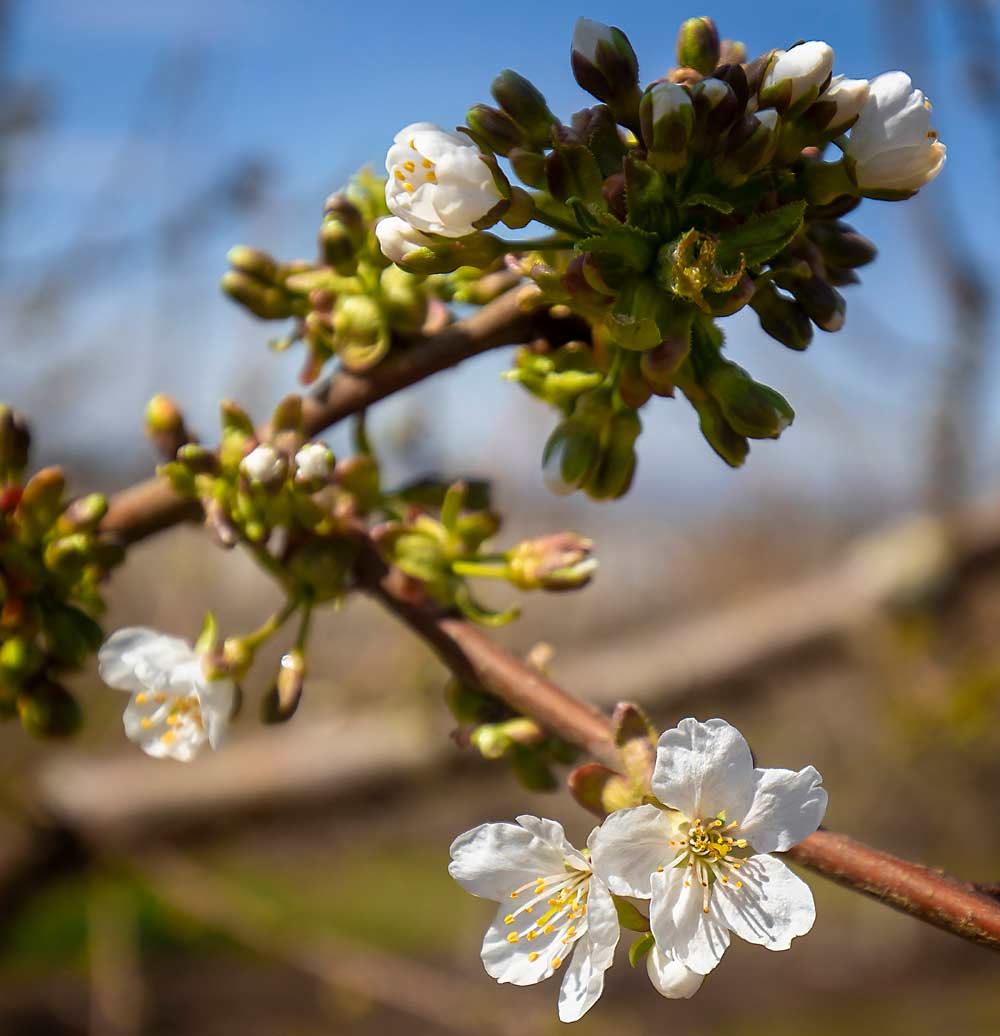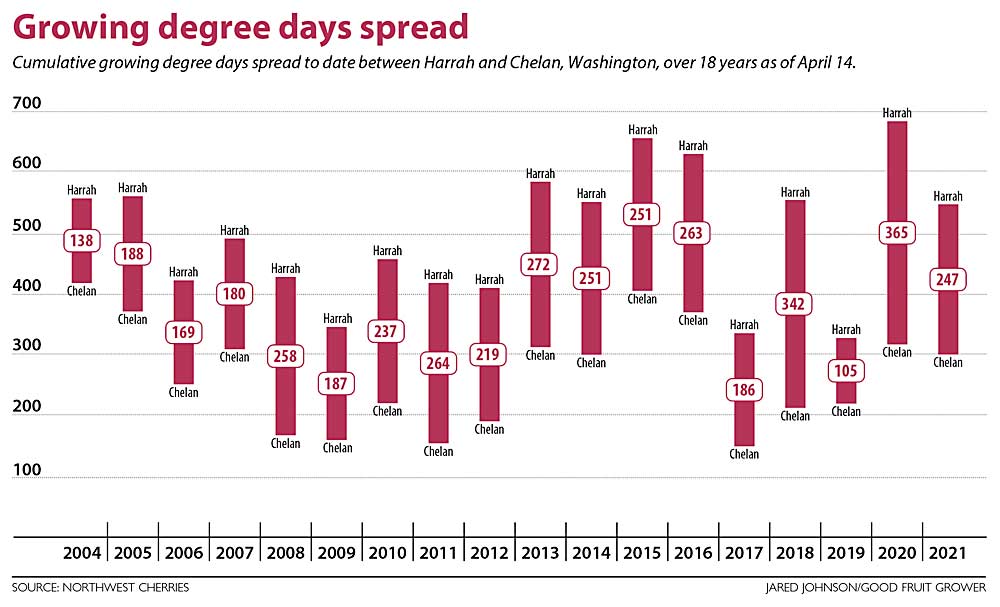B.J. Thurlby // May 17, 2021

We are a full year into the odd scenario that is a worldwide health pandemic. At this time last year, we had our hands full worrying about how a world in “lockdown” would impact our Northwest cherry crop. As it turned out, since the end of the season, a multitude of growers have reached out to ask: “What needs to happen for 2021 to go like 2020?”

The game plan the industry forged in late February 2020, with the goal to position a typical impulse purchase for pandemic success, was to focus promotional funding on online grocery sales and order sites while implementing the strongest health-message consumer outreach program ever. It worked: In the summer of 2020, cherries were the leader in absolute dollar gains for all U.S. produce departments. Cherries saw an amazing 86 percent year-over-year dollar growth, which is another way of saying that consumers were willing to pay more and eat more sweet cherries this past year.
Over the past several years, the Northwest cherry industry has had to deal with tariffs (from 25 percent to 60 percent) in China, its leading offshore market. This has had a downward pricing impact on grower returns while cutting the volume by more than half in our best export market. This has put further price pressure on both domestic and other export markets. The good news is that in 2020, there was enough worldwide demand to move the crop the growers picked.
The 2020 Northwest cherry harvest was the seventh largest crop ever shipped out of the five-state production region. The 2020 season ran from May 28 to Sept. 1, a total of 94 days of shipments. Combined, our final numbers indicate that the Northwest shipped just over 19.8 million 20-pound equivalent boxes. Likewise, the industry shipped 1.8 million 15-pound equivalent boxes of yellow/Rainier cherries.
But the demand curve was so steep that many in the industry were convinced the overall crop was very short. Certainly, strong demand can make a larger crop seem short, and in 2020 our growers were able to take part in a market that surprised even some of the longtime sales professionals. In retrospect, the keys to the success that the industry felt in 2020 were thus:
—Excellent eating quality fruit from start to finish.
—Twenty percent more shoppers using grocery stores as their source for meals, as most food service restaurants were closed.
—Northwest cherry online ad activity in both domestic and foreign markets. As it worked out, Americans spent over $7 billion ordering online grocery items in June.
—Health messages about cherries decreasing inflammation and boosting the immune system.
Looking ahead
As we enter the 2021 season, we will once again be dealing with a market that is severely affected by COVID-19 and an ongoing trade war with China. We will continue to find ways to drive demand for our fruit that is traditionally sold to consumers via grocery stores and purchased heavily on impulse.
Unfortunately, our retail partners are citing the potentially large California crop and our big bloom that is similar to what we saw in 2017, when growers took to market a 26 million 20-pound equivalent crop. I’ve already had several large retailers tell me that growers need to remember the challenges we faced in 2017 and get ready to aggressively promote this crop with aggressive promotions and retail price points.
However, the 2021 crop is going to be different than what we saw in 2017. For the first time in several years, we are seeing a significant frost season — where growers have had to heat to protect their fruit from cold nights that have dropped below 20 degrees Fahrenheit. With each frost event, the crop has been whittled down as buds and blooms have both been affected. Despite what appears to be a large “snowball bloom,” the fact that the industry is down over 2 million boxes due to little cherry disease, coupled with frost damage, has most of us thinking that we have a larger crop on the trees than in 2020, but far from the record crop we saw in 2017.
Another key nuance of the current crop is the excellent spread of degree day buildup that we are seeing between districts. We have had fairly warm spring weather and, based on our earliest bloom, it looks like our harvest will begin in the first days of June. In 2017, after the coldest Northwest winter on record, our earliest harvest began on June 8, but we didn’t really get going until June 15 and only shipped 7.7 million boxes in June — on a record crop year. Likewise, because of the late start, we saw fruit in early, mid- and late-season districts coming off at the same time. For a visual example, see the chart (above right) that shows growing degree day separation between Harrah (midseason) and Chelan (late season). The spread is 247 GDD hours so far this year, as compared to the 186 GDDs in 2017. The current spread is very positive for the goal of seeing separation in key volume districts — which should help give our industry sales organizations closer to 90 full days to sell the 2021 crop.
The point here is that every season is different, and the similarities between 2017 and 2021 are at this juncture minimal.

Healthy markets
As for the market in 2021, as the world slowly begins to reopen, there are more consumers heading back to food service restaurants. However, the reality is that 70 percent of Americans are now cooking at home, compared to 51 percent in 2019, and that trend is expected to continue through this summer.
Recent consumer research done by Acosta Marketing indicates that one of the primary drivers of shopper behavior during the pandemic has been a renewed focus on healthy eating. Our cherries match up to this trend perfectly. Likewise, our health-based research and consumer outreach over the past 10 years has pushed our cherries into the center of the “superfruit” subcategory.
It’s important that we never lose sight of the pure enjoyment of a bowl of cherries. For many, sweet cherries are a sign of summer. No matter how many health benefits they pack, the sweet crunch of a ripe cherry is what excites that emotional response for many consumers. But in the increasingly competitive world of produce, relying on a consumer’s emotional connection to a fleeting seasonal product simply isn’t enough. So, backing up the pure eating pleasure of a Northwest cherry with a host of health benefits has long been a focus of the Northwest Cherry Growers.
Fortunately, it appears that the health research investments our growers have made over the past decade have created an impact. In a consumer survey performed last year, nearly two out of three buyers reported that the health benefits of cherries influenced their ultimate decision to purchase.
As the world emerges from a year of coping with the pandemic, consumers everywhere have indicated that they will be looking to re-engage their health. Whether it’s weight loss, better sleep, improving their workouts or addressing a specific ailment, cherries have built an impressive repertoire of claims that will all be a part of our 2021 promotions. For the summer ahead, the Northwest Cherry Growers are lining up the biggest consumer campaign in our organization’s history, and it will be focused solely on educating consumers on the benefits of consuming fresh, sweet Northwest cherries. We do not make this investment of grower dollars without closely studying consumer and retail trends from around the world — and we believe that despite the ongoing pandemic, there is a unique opportunity to position our fruit as the anti-inflammatory immune system boosters they are.
Each season, our team leverages our grower investment into promotional campaigns with a high return on investment. With sponsorship sessions at the largest dietitian and nutritionist conferences in the country and direct outreach to our database of nearly 3,000 nutrition professionals, we’re working to develop cherry messages with those who make recommendations and meal plans for consumers across the country. Aligned with that, we’ve partnered with registered dietitian influencers who maintain a high level of confidence with consumers. A combination of national streaming ads, publisher partnerships, social media contests and news releases will overlap to create a blanket of in-store and online messaging for the course of our season.
Thanks to careful and select execution of these programs in target markets in the past, each component of the health stimulus promotion has been proven to be a reliable outreach tool. This season, we are taking what we’ve learned and are turning the dial up to 11 on those programs proven to bring visibility during our fresh season. If ever there was a summer to highlight the benefits that our sweet snacks can bring to a family, then the summer of 2021 is it. As my sage grower friend, Mr. Charlie de la Chapelle, said at this past winter’s Hort Show, “Starve your problems and feed your opportunities.” Expanding the Northwest cherry health message during the pandemic is an opportunity we intend to feed in 2021. •
—by B.J. Thurlby
"fruit" - Google News
May 17, 2021 at 09:14PM
https://ift.tt/3hBaHse
Thurlby: Make room for blooms - Good Fruit Grower
"fruit" - Google News
https://ift.tt/2pWUrc9
https://ift.tt/3aVawBg
Bagikan Berita Ini















0 Response to "Thurlby: Make room for blooms - Good Fruit Grower"
Post a Comment